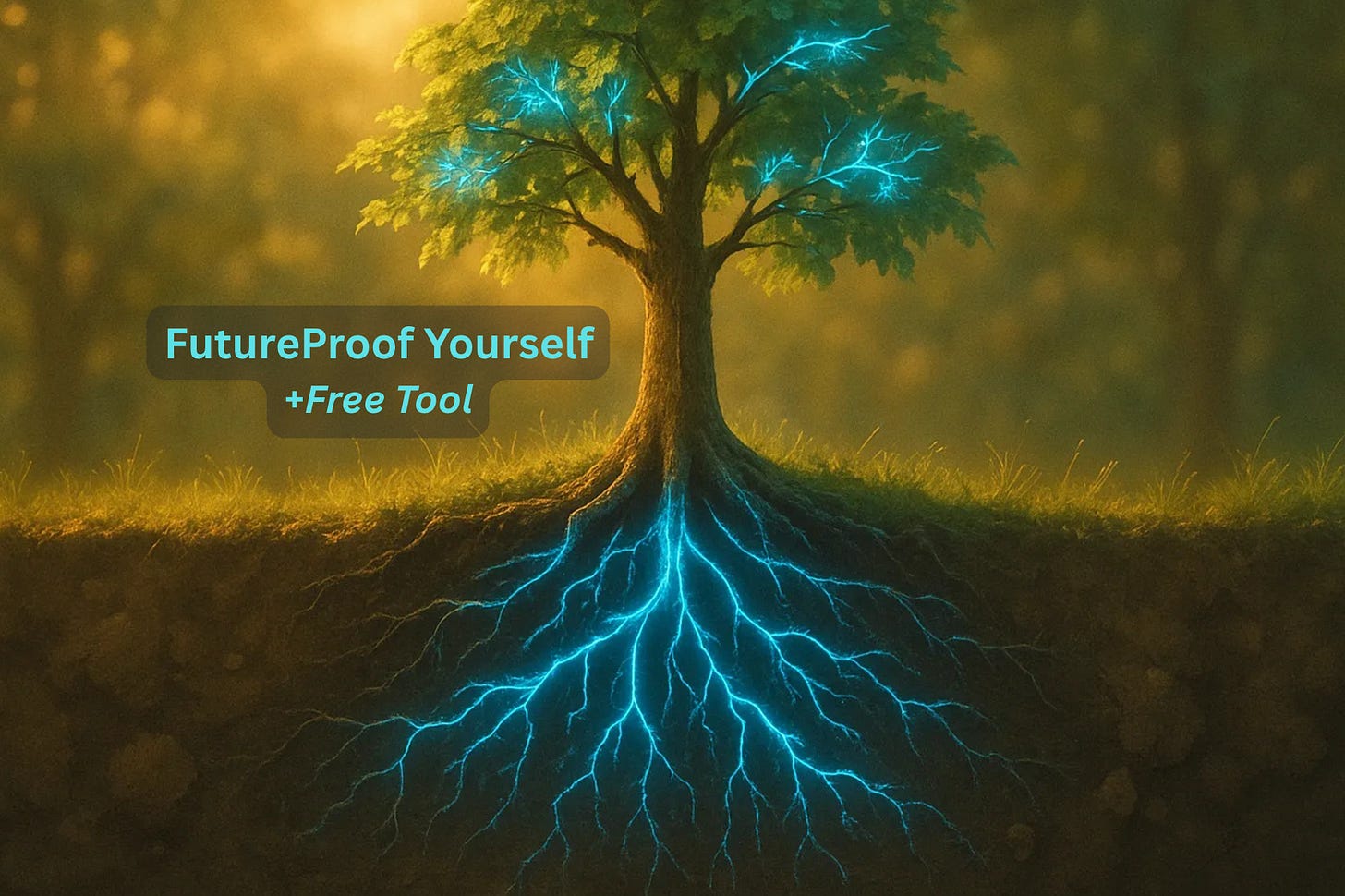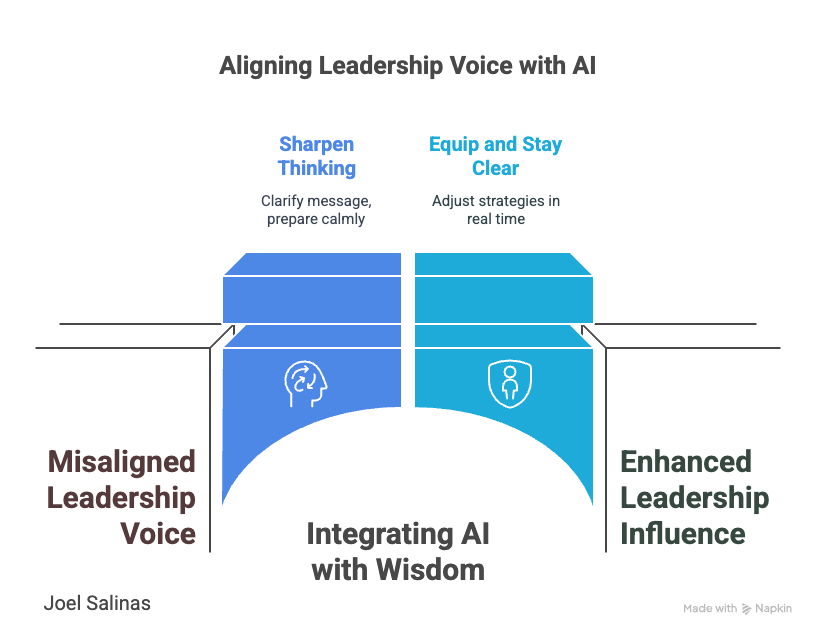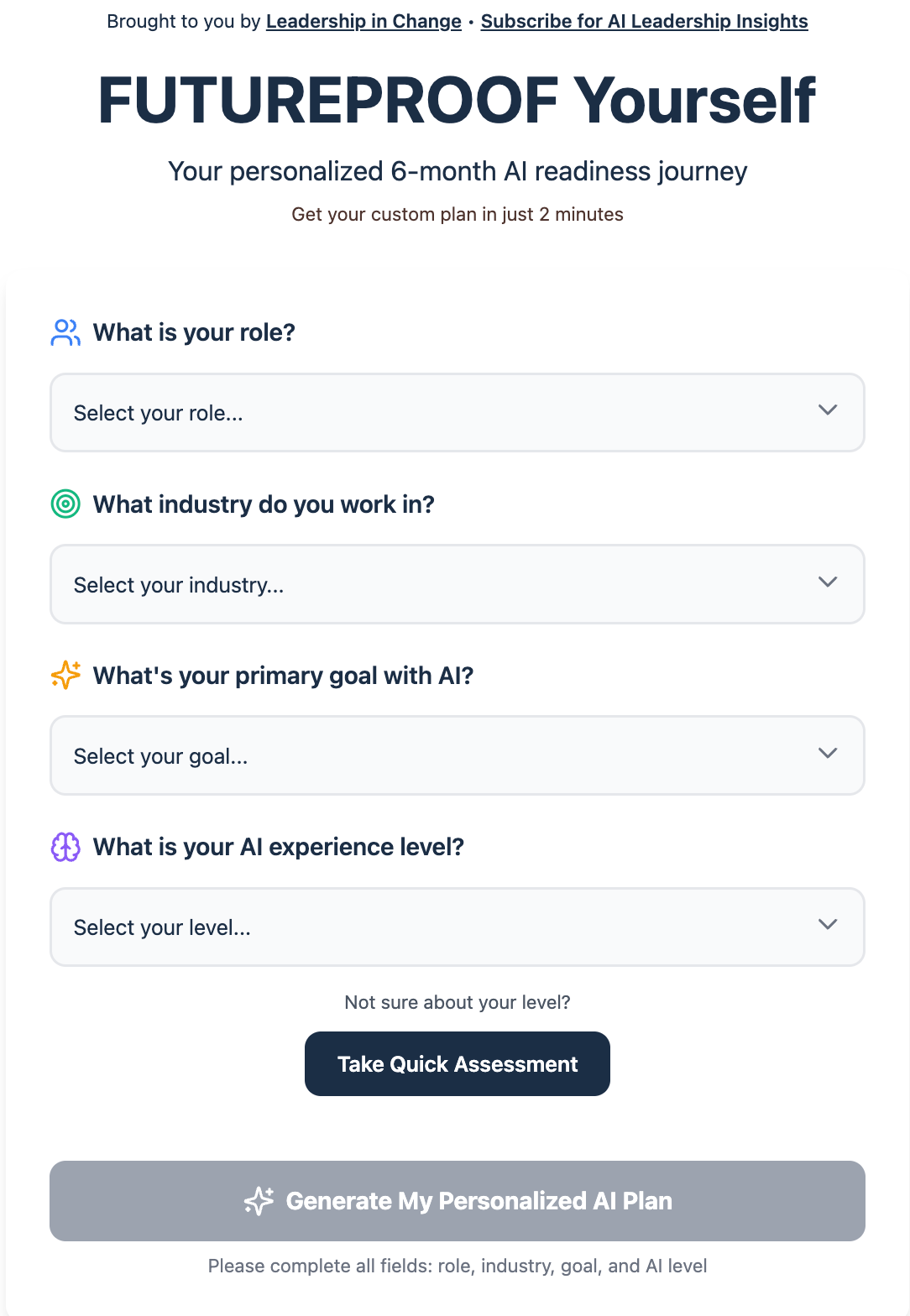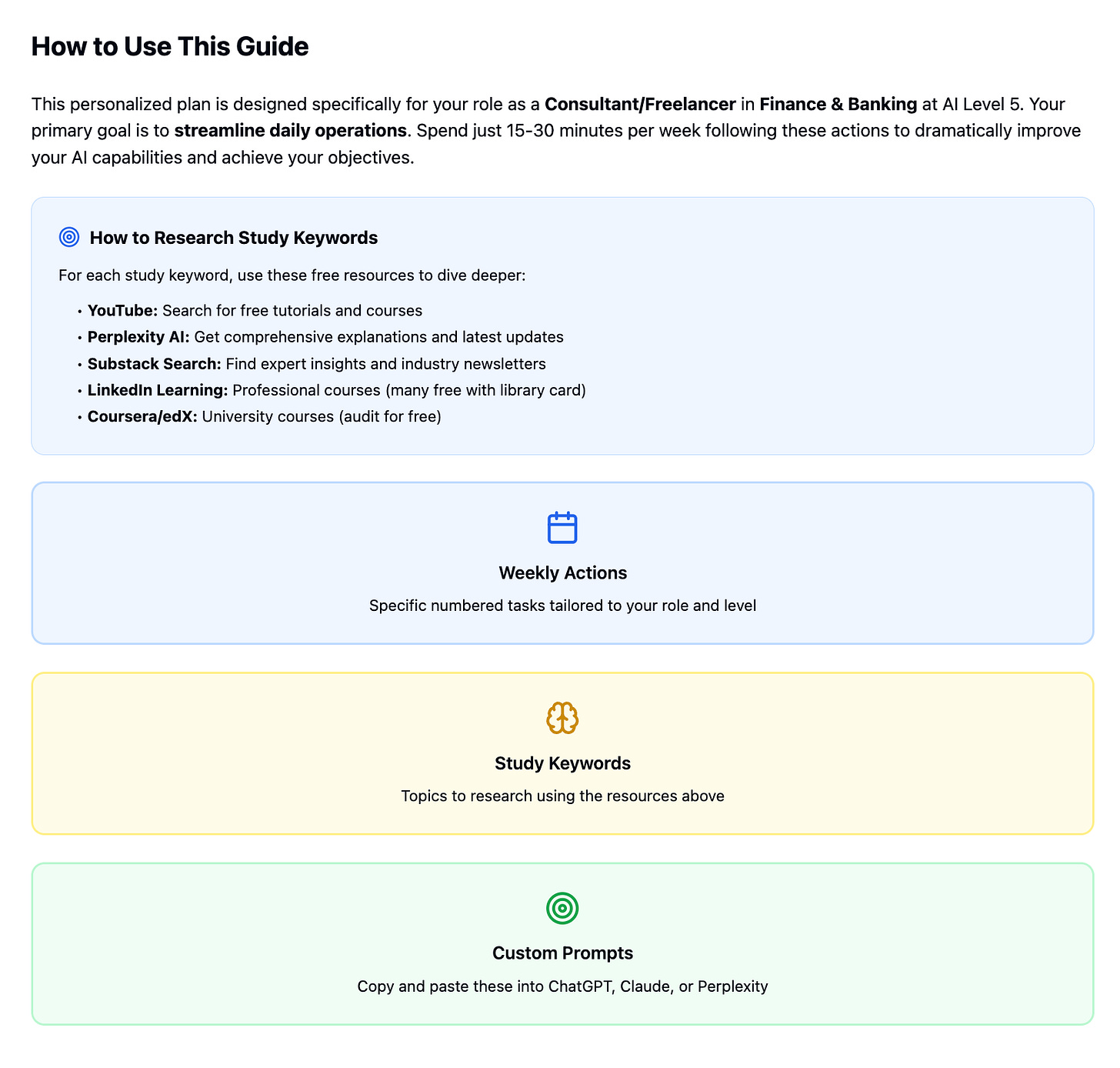Futureproof Yourself: Are You Becoming AI-Enhanced or AI-Replaceable?
+ Free tool: Create your 6-month AI growth plan—customized to your role and AI comfort level.
Let’s stay connected—find me on LinkedIn and Medium to further the conversation.
When electricity first emerged, it was a luxury… curious, novel, and optional. But eventually, it wove into every industry, every home, every workflow. It stopped being a tool and became a foundation.
AI is following that same trajectory. I’m convinced that what feels new or optional today will soon be embedded in every system and decision-making structure we touch. Those of us who understand this, who lead with this in mind, who start preparing now, are the ones who won’t just survive the transition. They’ll shape it.
But let’s name the tension honestly: many feel lost. You may have felt or currently feel uncertain. Not because they’re unwilling to learn, but because they’re overwhelmed by noise and uncertainty.
A few weeks ago, I chatted with a friend who looked tired. Not because of the usual startup fatigue, but because he felt behind.
"Everywhere I turn," he said, "people are talking about AI. But no one tells me what to do with it."
He’s smart, experienced, and deeply valued by his team, but is worried, seeing the headlines about job replacement. Like him, you may be wondering:
Will there still be a place for someone like me?
Or if you have children…
“How do I prepare them for a world where AI is everywhere?”
The fear of being replaced by AI is very real. And is joined by a similar one, quieter: being bypassed. Being in the room but not equipped to shape what's next.
I’m watching a growing divide: those who know how to use AI to amplify their real strengths... and those who either ignore it or misuse it, treating AI as a shortcut rather than a strategic partner.
This article and the tool I provide are my way to help.
The Growing Divide: AI-Enhanced vs. AI-Replaceable
Many studies predict AI could replace up to 300 million jobs globally, nearly 10% of the workforce. But the headlines often miss the real shift.
As CNN Business put it:
“It’s job transformation. Human jobs will be replaced—but mostly by other humans using AI.”
In other words, it’s not AI that’s replacing you.
It’s the person in your same role who’s using it wisely, calmly, and clearly.
The Divide Isn’t Just Technical, It’s A Mindset.
I see it constantly:
Two people. Same position. Same mission.
One uses AI to prepare a strategy with clarity and write with confidence, enhancing expertise and expanding his or her reach.
The other copy-pastes prompts into ChatGPT, hoping the results sound polished enough to pass.
This isn’t a question of intelligence or value.
It’s a question of alignment.
The danger isn’t the tool. It’s misusing the tool in a way that disconnects you from your own voice.
That’s what creates the divide, not AI itself, but whether you’re aligned with how it shapes your thinking, message, and presence.
Visual Framework: Bridging the Divide
Let me show you what this looks like:
This isn’t about tech skills. It’s about how you align your leadership with AI. Think of it as a bridge, one every leader should cross.
1. Misalignment — AI replaces thinking
On the left, leadership and AI are disconnected. Messages grow fuzzy. Strategies turn reactive. Presence is diluted. The tool begins to think for you.
2. Integration — AI sharpens clarity
In the middle, the shift begins. AI becomes a thought partner—not to automate everything, but to enhance your reflection, speed up execution, and help you stay clear under pressure.
3. Amplification — AI multiplies presence
On the right, we see the result of wise alignment. The leader moves faster, communicates more clearly, and shows up more grounded. AI doesn’t replace their leadership. It deepens it.
This is what I call someone who is AI Supercharged. That is a perfect sync between you and AI that doesn’t dull, but expand.
This isn’t about becoming more robotic. It’s about becoming more human, with tools that finally match the complexity of who you are.
What AI Reveals
AI doesn’t create clarity. It amplifies what’s already there or exposes where it’s missing if used correctly.
Use it to bypass reflection, and you become more reactive.
Use it to replace hard thinking, and you slowly dull that ability in yourself.
Avoid it altogether, and others begin to shape the decisions without you.
“AI doesn’t replace people. It replaces patterns of thinking that don’t adapt.”
Used well, AI doesn’t weaken your leadership.
It multiplies your presence and purpose.
What’s Really at Stake
This isn’t about becoming a tech expert. It’s about not standing still while others move forward, often with less experience, but more clarity.
Because here’s what’s happening behind the scenes:
Teams are quietly shifting influence to whoever brings speed (with AI) and substance.
Creatives, pastors, managers, those who partner with AI wisely, are shaping what’s next, not reacting to it, through AI. In fact, check out how Spiritual Leaders are using AI daily to magnify their impact.
So, Where Do You Begin?
You don’t need to master AI. But you do need to work to understand it and figure out how to use it in a way that matches your mission and voice.
That’s exactly what the next section is designed to help you do.
I built a tool to help close this divide with a guided plan.
A Tool Built to Close the Gap
Ignoring AI is no longer neutral. It’s risky.
If someone else brings your same skillset, but knows how to use AI to move faster, think clearer, and adapt better, they’re going to stand out.
That’s why I built this tool: to help close that gap with wisdom, not panic.
What It Is:
A structured Claude-powered free tool that creates a 6-month AI growth plan, tailored to:
Your current or future role (you can add the role you want to have)
Your real AI comfort level or experience (even if you are already building AI agents)
What you most want to get from AI
It guides you through a short reflection, then delivers a plan you can follow at your own pace, with learning themes, prompts, and next steps.
You don’t need to be technical. You just need a path.
What You Get:
Weekly action steps to build habits
Monthly study keywords to guide your learning
One custom prompt each month, matched to your role and what you learned that month
Adaptable structure for any skill level, from AI beginner to agent builder
Fully role-based—whether you’re a nonprofit leader, manager, creator, or nurse
Here’s what results look like for a LEVEL 5 AI Consultant in Finance, month 1…
If you try this tool, please reach out to me with any feedback to improve it. And feel free to share it!
If You Only Remember This
The real threat isn’t AI replacing you. It’s not knowing how to use it to enhance your leadership.
The divide is growing between AI-amplified leaders and those left behind.
You don’t need to be technical. You need a plan.
The FutureProofYourself tool gives you clarity, not hype.
Start now, before your role gets redefined without your input.
Recommended Reading
"The Coming Wave" by Mustafa Suleyman – A clear-eyed look at the future of AI and what it means for society and leadership.
"Deep Work" by Cal Newport – A powerful guide to focusing your mind and developing skills that won’t be automated away. (Affiliate links used)
"When AI Stops Being a Tool and Becomes Your Thinking Partner" – A collaborative piece I co-authored with five other AI creators exploring the deeper shift from tools to thought partners. If you don’t know them, check out their work… Wyndo, Jenny Ouyang, TechTiff, Ryan Ong, Ph.D. 🎮 & Daria Cupareanu.
If you use the tool and have feedback, thoughts, or suggestions, comment below! I read every reply.
(Affiliate links used)








Loved this line: “AI doesn’t replace people. It replaces patterns of thinking that don’t adapt.”
I'd add that it's not only about thinking, but also adapting to the fact that the value equation of the role has changed entirely, as AI actually absorbs parts of the job
Great post, Joel! I’m seeing a lot of the same things. The gap is widening between those using AI to deepen their strengths and those who see it as just a shortcut. When people treat it like a partner by asking better questions and building on their own insight, it becomes a serious edge. But if it’s used to bypass thinking, the results fall flat. Your framing really brings that into focus.